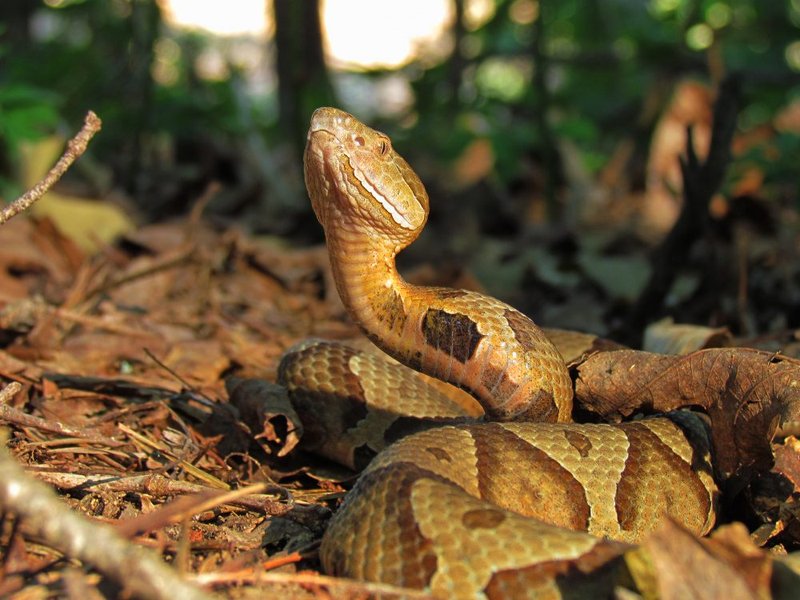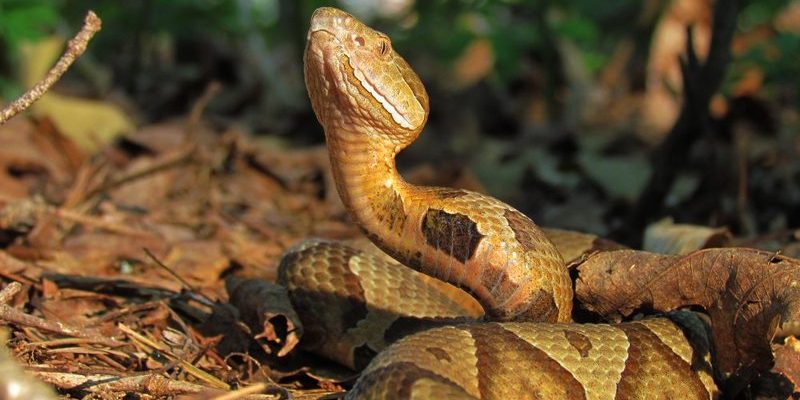
The Copperhead is a fascinating snake that captures the imagination of many nature enthusiasts and curious minds alike. Found primarily in the eastern United States, these snakes are known for their distinct coloration and unique behaviors. Imagine spotting a snake that blends skillfully with its surroundings, just like a piece of art hidden in nature’s gallery. This unmatched camouflage is one of the many reasons why the Copperhead is so intriguing.
When you think about snakes, you might picture something dangerous or frightening. But here’s the thing: Copperheads are often misunderstood. While they do possess venom, their bites are relatively rare and rarely fatal to humans. Instead, they tend to be reclusive, preferring to avoid confrontations. In this article, we’ll explore everything you need to know about these remarkable reptiles, from their habitats to their behaviors and diet.
Physical Characteristics of Copperheads
Copperheads are medium-sized snakes, typically ranging from 2 to 3 feet in length. However, some individuals can even grow up to 4 feet long. Their most striking feature is their coppery-orange head, which gives them their name. The body is adorned with a series of hourglass-shaped markings that vary in color—from light tan to a reddish-brown. This natural design serves a dual purpose: it not only provides camouflage against the forest floor but also helps them blend in with the fallen leaves.
One interesting fact about their appearance is their eyes. Copperheads have vertical pupils, similar to those of a cat, which allows them to hunt effectively, especially in low-light conditions. This adaptation makes them stealthy predators, capable of waiting patiently for their next meal. Their scales are smooth and shiny, further enhancing their beauty. If you get lucky enough to spot a Copperhead in the wild, you might just find yourself mesmerized by their intricate patterns.
Habitat and Range
Copperheads are primarily found across the eastern and central United States, ranging from southern New England down to Texas and parts of Mexico. They thrive in a variety of habitats, including deciduous forests, rocky hillsides, and even suburban areas. It’s fascinating how adaptable they are! You might find them basking in the sun on a warm rock or coiled up in a pile of leaves, taking advantage of the natural cover.
These snakes prefer areas with plenty of shelter, such as rocky outcrops or dense underbrush. Their choice of habitat is not just about being comfortable; it also plays a crucial role in their hunting strategies. By being in places where prey is abundant—such as rodents and small birds—Copperheads can easily find food. They are also excellent climbers, so don’t be surprised if you see one slithering up a tree or a fence post!
Diet and Hunting Behavior
The Copperhead’s diet primarily consists of small mammals, birds, and even amphibians. They are ambush predators, meaning they rely on stealth and patience to catch their prey. Imagine a hunter lying in wait, completely still, until the perfect moment arrives. Copperheads employ a similar strategy, often remaining motionless for long periods before striking.
When a Copperhead senses movement nearby, it strikes quickly, injecting venom into its prey. This is where their venom comes into play—it helps subdue the prey, making it easier for the snake to consume. Once the creature is immobilized, the Copperhead will swallow it whole, which can be quite a sight! Their ability to eat large prey helps sustain them, particularly during colder months when food might be scarce.
Reproduction and Lifespan
Copperheads are unique among North American snakes in that they are ovoviviparous, which means the females give birth to live young rather than laying eggs. Breeding usually occurs in the spring, and female Copperheads will give birth in late summer to about 5 to 15 young snakes. Each baby Copperhead is a miniature version of the adult, equipped with the same stunning colors and patterns.
The lifespan of a Copperhead in the wild can range from 10 to 20 years, although factors like predation and habitat loss can impact their longevity. In captivity, they tend to live even longer, sometimes exceeding 25 years with proper care. Isn’t it amazing to think about how long they can thrive when provided with the right conditions?
Venom and Human Interactions
While Copperheads are venomous, their bites are rarely life-threatening to humans. Most incidents occur when someone accidentally steps on or provokes a snake. In such cases, the snake may bite in self-defense. If you were to get bitten, it’s important to seek medical attention promptly, but know that fatalities from Copperhead bites are extremely rare—a fact that surprises many.
Education plays a crucial role in reducing negative interactions between humans and Copperheads. Many people fear these snakes without understanding their behavior. By learning to recognize their habitats and respecting their space, we can coexist peacefully with them. If you happen to encounter a Copperhead, remember to observe from a distance and give it plenty of room to escape.
Conservation Status
As with many wildlife species, habitat preservation is vital for the Copperhead’s survival. Urbanization, deforestation, and agricultural practices have led to habitat loss, which can threaten local populations. Many people might not realize that by protecting the environment, we’re also safeguarding these incredible snakes. Conservation efforts are underway in various regions to ensure they continue to thrive.
Moreover, educating the public about the importance of snakes in our ecosystem can help foster a more positive perception. Copperheads play a crucial role in controlling rodent populations, for example. Without them, these populations could explode, leading to more significant problems for crops and human health. Understanding their ecological importance can encourage people to view Copperheads as beneficial rather than harmful.
Interesting Facts About Copperheads
| Size: | 2 to 4 feet |
| Habitat: | Forests, swamps, and urban areas in the eastern US |
| Diet: | Rodents, birds, amphibians |
| Lifespan: | 10 to 20 years in the wild; up to 25 years in captivity |
| Reproduction: | Live birth (ovoviviparous) |
FAQ
Are Copperheads aggressive towards humans?
Copperheads are not typically aggressive. They prefer to avoid confrontation and will often flee if they sense danger. Most bites occur when people accidentally step on them or try to handle them. It’s best to admire these snakes from a distance and respect their space.
How can I identify a Copperhead?
A Copperhead is recognizable by its distinctive coppery-orange head and hourglass-shaped patterns on its body. They are medium-sized snakes, usually 2 to 3 feet long, with a smooth and shiny appearance. If you see a snake that matches this description in the eastern United States, there’s a good chance it’s a Copperhead!
What should I do if bitten by a Copperhead?
If bitten by a Copperhead, remain calm and seek medical attention immediately. It’s crucial to avoid using a tourniquet or trying to suck out the venom, as these methods can do more harm than good. Instead, keep the affected limb still and at or below heart level until help arrives.
Do Copperheads hibernate?
Yes, Copperheads do hibernate during the cold winter months. They typically seek shelter in rock crevices, under logs, or in other protected areas. Hibernation helps them conserve energy when food is scarce and temperatures drop. As spring arrives and temperatures rise, they emerge to bask in the sun.
What do Copperheads eat?
Copperheads primarily feed on small mammals, birds, and amphibians. Their diet mainly consists of rodents like mice and young rats. They are ambush predators, waiting patiently for the perfect moment to strike and capture their prey using their venom.
Can Copperheads swim?
Yes, Copperheads are good swimmers! They can often be found near water sources, such as streams or ponds, and will swim when necessary. Their ability to adapt to various environments makes them versatile hunters and survivors.
How can I help protect Copperheads?
To help protect Copperheads, support conservation efforts and educate others about their ecological importance. Avoid destroying their habitats and encourage practices that preserve natural environments. Awareness and respect for wildlife are key steps in ensuring their continued survival.
Where can I find Copperheads?
Copperheads are primarily found in the eastern and central United States. They inhabit a variety of environments, including deciduous forests, rocky hillsides, and even suburban areas. If you’re exploring these regions, keep an eye out for these beautiful snakes!
Are Copperheads the same as other types of pit vipers?
Copperheads are indeed a type of pit viper, which means they possess heat-sensing pits located between their eyes and nostrils. They are part of a larger family of snakes that includes rattlesnakes and cottonmouths. Like other pit vipers, Copperheads use these pits to detect warm-blooded prey, making them efficient hunters.
What happens if I encounter a Copperhead in the wild?
If you encounter a Copperhead in the wild, the best course of action is to remain calm and give the snake space to move away. Avoid sudden movements, and don’t attempt to touch or capture the snake. Observing from a distance is the safest way to appreciate these incredible creatures.
Are there any myths about Copperheads?
Yes, there are several myths surrounding Copperheads. One common myth is that their venom is highly dangerous, which can lead to unwarranted fear. In reality, although they are venomous, bites are rarely fatal, and Copperheads are generally not aggressive. Understanding these myths can help foster a more positive relationship with these snakes.

